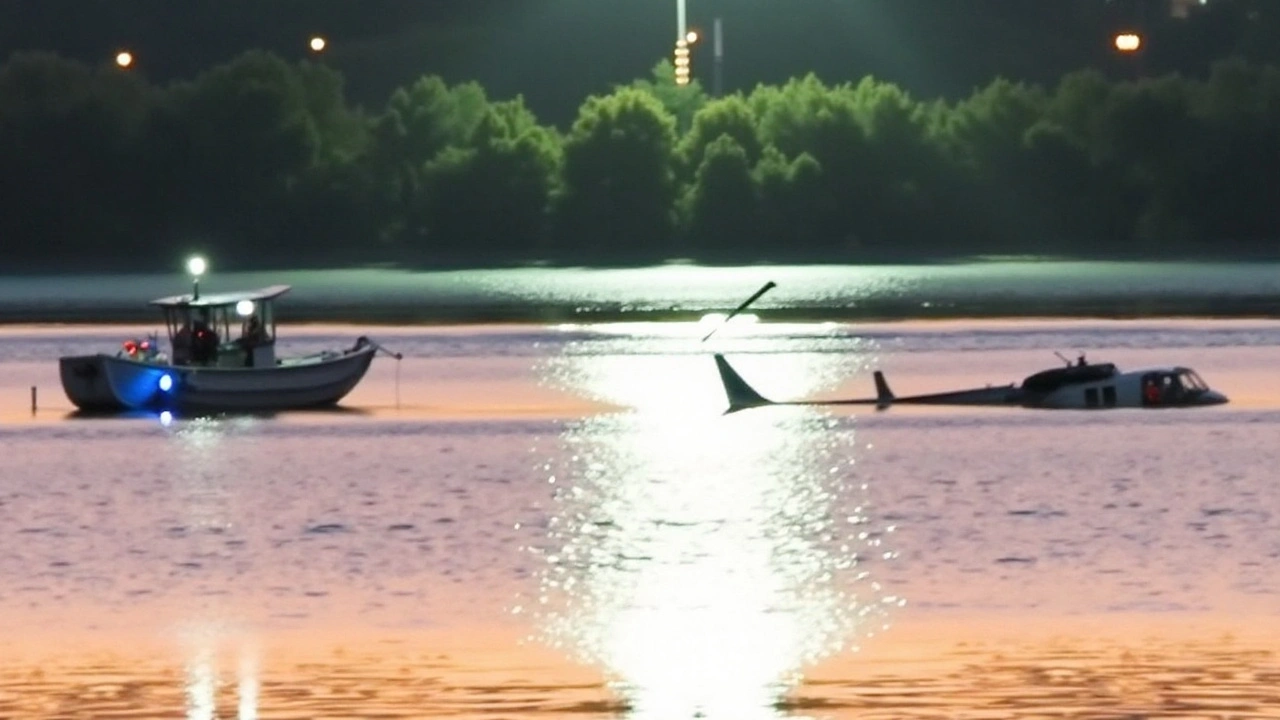Catastrophic Collision Over Capital Skies
A tragic and unexpected event unfolded in the skies over Washington DC, capturing the attention and concern of the nation. An American Airlines passenger jet, identified as PSA Airlines flight 5342, collided with a Sikorsky Black Hawk helicopter from the United States Army. This devastating collision occurred on the final day of January 2025, as the passenger plane was making its final descent into Reagan Washington National Airport. The commotion of daily life in the capital was abruptly interrupted as the two aircraft went down, crashing into the icy Potomac River.
The havoc began above one of the nation’s busiest airspaces. As the airline jet approached from Wichita, Kansas, the Black Hawk, belonging to B Company, 12th Aviation Battalion stationed at Fort Belvoir, Virginia, was conducting a routine training flight. The sky was bustling as usual, but tragic fate took the reins, leading to a disaster that shocked both the aviation and local communities.
Immediate Aftermath: From Search and Rescue to Recovery
The impact was immediate and catastrophic, leaving both the jet and helicopter plummeting into the waters of the Potomac River. In the chaos that ensued, local authorities quickly mobilized a massive multi-agency search and rescue operation, digging into the bitter cold of the river in hopes of uncovering survivors. Helicopters whirred overhead, and boats crisscrossed the freezing waters as rescue teams attempted to piece together what remained. Yet the hopes of a miracle dimmed as hours passed, transitioning the operation into a grim recovery mission.
The scale and speed of the response illustrated the severity of the crash, with Reagan Washington National Airport halting all arrivals and departures. Despite the severity of the incident, the airport’s terminal remained open, buzzing with the anxious chatter of travelers stranded by the magnitude of the tragedy unfolding so closely. The frigid wintery conditions added layers of complexity to the rescue efforts, challenging authorities striving to secure the crash site and recover all victims.
Loss of Lives: The Solemn Toll of the Disaster
Among the wreckage, sadly, there were no survivors found from either aircraft. The passenger jet carried 60 passengers and four crew members, while three Army officers manned the helicopter. By Thursday evening, the somber recovery efforts had retrieved 40 bodies from the river. Some of the victims were later identified as rising stars in the world of figure skating, including Jinna Han, Spencer Lane, Vadim Naumov, and Evgenia Shishkova, returning from a joyous and promising National Development Camp. These skaters represented dreams and talents from Russia and the United States, extinguished in a flash.
Other identified victims included Asra Hussain Raza and four committed members of the Steamfitters United Association Local 602. The national tragedy cut across varying walks of life, uniting families in unspeakable grief. The helicopter’s crew, though lesser in number, was no less impactful. Ryan O’Hara, the 29-year-old crew chief, was among those onboard, now hailed for his service cut short abruptly.
Political Repercussions: Leadership and Criticism
The disaster reverberated beyond the immediate families and emergency responders. President Trump, in responding to the tragedy, confirmed the harrowing news that no one survived. In his address, he voiced criticism targeted towards the Biden administration, though without directly attributing any blame for the crash itself. His sentiments echoed the frustration and search for accountability that often follows such dire events.
Furthermore, during the same announcement, President Trump made administrative changes, appointing Christopher Rocheleau as the acting commissioner of the Federal Aviation Administration (FAA). This move signals the administrative redirection and heightened scrutiny often leveraged in the wake of national emergencies and aviation incidents of this magnitude.
Ongoing Investigation: NTSB at the Helm
As the public grapples with shock and sorrow, the National Transportation Safety Board (NTSB) bears the burden of uncovering the cause behind this calamitous event. Investigators have recovered the flight data recorder and cockpit voice recorder from the wreckage, crucial components in piecing together the tragic sequence of events leading up to the collision. The recorders are expected to offer insights into the final moments, conversations within the cockpit, and any anomalies recorded in flight operations.
The NTSB’s methodical approach highlights the complex nature of such investigations. It involves a meticulous reconstruction and analysis of the aircraft's paths, weather conditions at the time, communication records, and the functionality of warning systems designed to prevent mid-air collisions. Each component is crucial to not only providing closure to grieving families but also to preventing future disasters, reinforcing the safety standards that millions of passengers globally rely on.
This heartrending incident has left a significant mark on aviation history, emphasizing the constant vigilance required amid one of the safest modes of transport. As Washington DC and the broader nation mourn, the collective hope remains that from these dark times arise lessons learned, steering the way to advancements in flight safety, technology, and cooperation between civil and military flight operations.







Comments
Vaneet Goyal
This is beyond tragic. Sixty passengers, four crew, three military personnel-all gone in an instant. No room for excuses, no room for politics. The FAA needs to overhaul its deconfliction protocols between civil and military airspace. The Potomac isn't a training ground. The recorders will tell us what went wrong, but the real failure happened long before the collision. We need systemic change, not just condolences.
Amita Sinha
I just saw a TikTok of one of the skaters practicing last week. They were smiling so hard. Now they’re just... gone. Like a YouTube video that got deleted. Why does this always happen to the good ones? 🥺💔
Bhavesh Makwana
There’s something deeply human about how we react to these moments. We don’t just mourn the numbers-we mourn the stories. The skaters who trained since they were five. The steamfitters who fixed pipes in freezing basements so kids could stay warm. The Army crew who flew because someone had to. This isn’t just an accident. It’s a fracture in the quiet rhythm of ordinary lives. We owe it to them to not just remember, but to rebuild smarter.
Vidushi Wahal
I read the NTSB report draft last night. The radar data shows the helicopter deviated 0.8 nautical miles from its assigned corridor. No warning alerts triggered. The jet’s TCAS was functional. But the controller didn’t see it on his screen until impact. It’s not one failure. It’s layers. And we keep adding layers instead of removing them.
Narinder K
So Trump appoints a new FAA commissioner the same day as a crash. Coincidence? Or just the most efficient way to distract from the fact that the FAA’s budget got slashed in 2023 and no one fixed the radar blind spots? Classic.